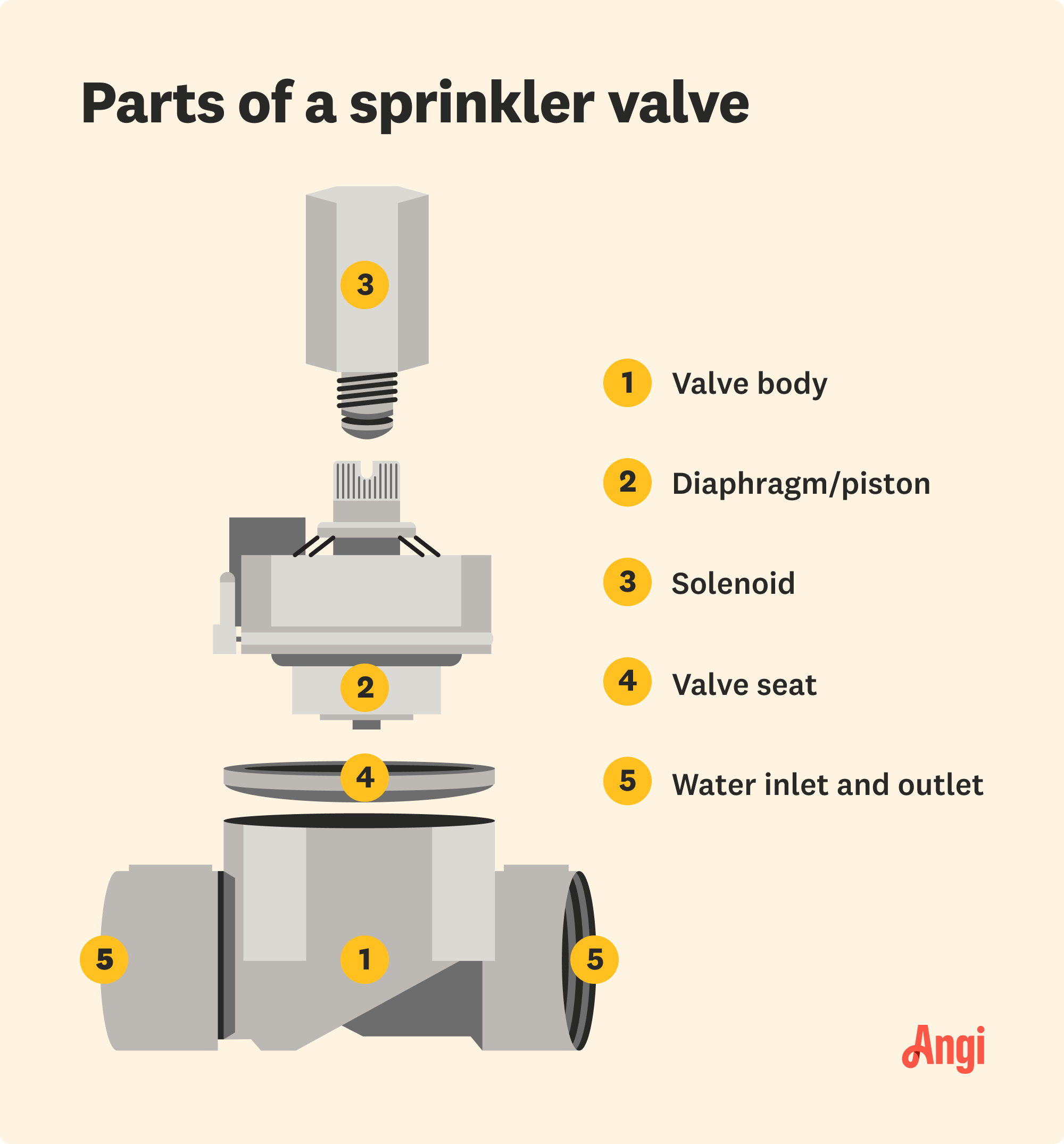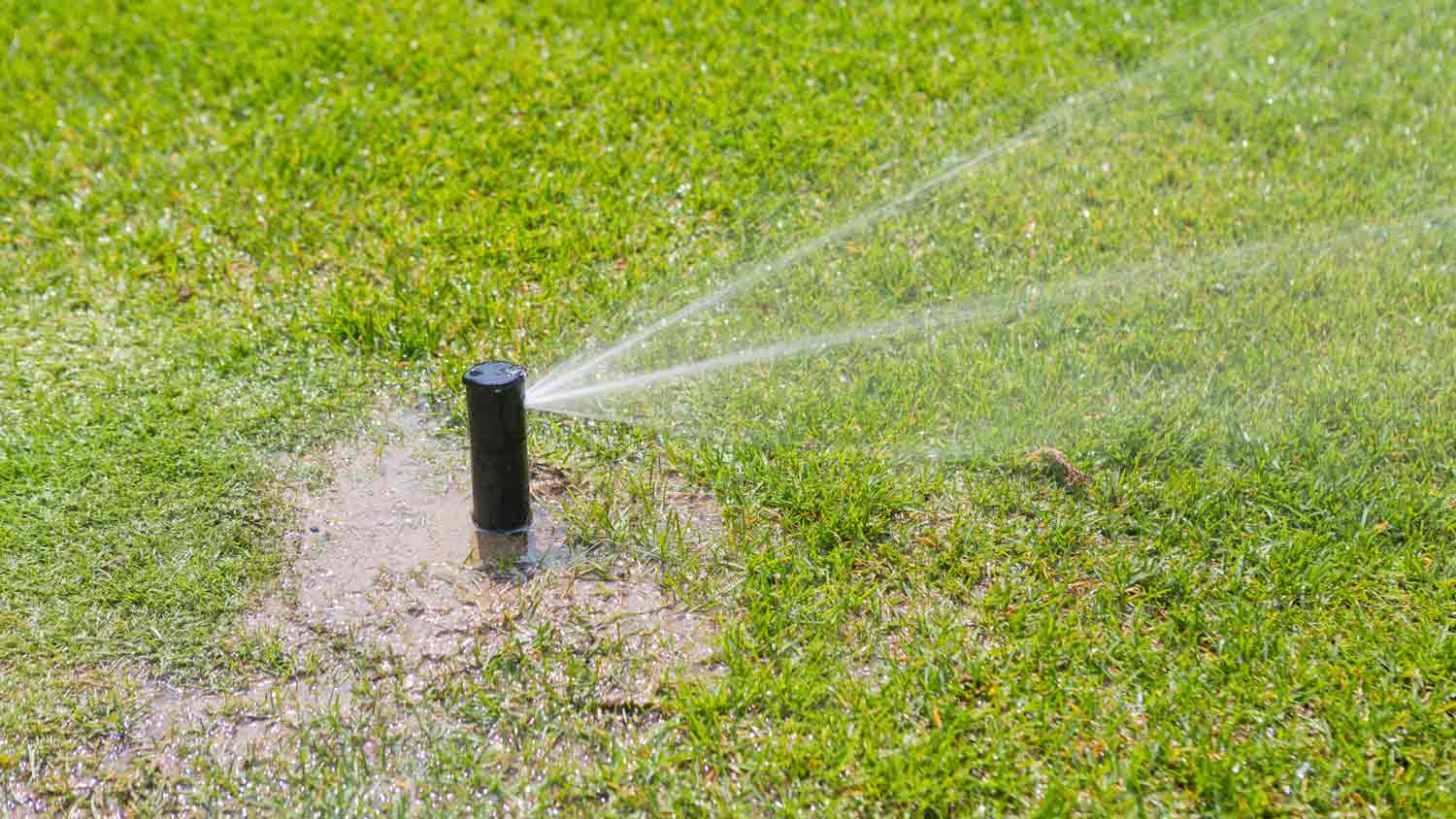
Discover drip irrigation system cost estimates, key price factors, and ways to save. Get transparent pricing to plan your home irrigation project confidently.
Don’t let a valve leak put a damper on your sprinkler system


Low head drainage and diaphragm seal breaks are the main causes of valve leaks.
An unusually wet yard, high water bills, and low water pressure are some signs of a leak.
The price of a replacement sprinkler valve or part ranges from $13 to $150.
If the leak is extensive, you may need to call a plumbing company for an inspection.
Homeowners use landscaping sprinkler systems to keep their lawns and gardens thriving, even in the driest summer months. However, it’s common to discover your sprinkler water valve is leaking and not spraying properly.
Over time and with normal wear and tear, the system's valves can deteriorate and cause leaks. Luckily, sprinkler water valve leaking is easy to spot and, depending on the cause, an easy fix for most homeowners, but calling a sprinkler repair company is always best for major issues. Let’s review the common causes of this issue and its warning signs.
When you run your sprinkler system and switch it off, there may be excess water still draining from the pipes. When leaks happen at this time, the issue is known as low head drainage. The drainage issue should stop shortly after you turn the sprinkler off. If it doesn’t, you may have a sprinkler valve leak.
Check to see if you have a low head drainage issue by turning off all running water on your property, including faucets and showers inside. Look at your water meter to see if the dials are moving. If they are, you have a low-flow leak.
Install check valve sprinklers or retrofit your existing sprinklers with check valves, especially the lowest head in each zone. The check valve holds the water and eliminates drainage. You can also hire a local sprinkler repair professional who can determine whether to repair or replace the sprinkler water valve. The pros will inspect your system to isolate the damaged part and ensure the rest of the system is working properly.
The rubber seal or diaphragm in the system’s valve box can deteriorate and stop working properly due to normal wear and tear. When it does, water flows through the system freely or debris begins to block the valve and prevent it from closing.
Turn off the water to your irrigation system, locate your valve box, and remove the cover. Take out the solenoid and remove the bonnet to access the inside of the valve. Then, replace the rubber diaphragm with the correct replacement part and reassemble the valve components.
This type of damage to your sprinkler valve only worsens over time, so it’s essential to address it quickly to prevent more extensive (and costly) leakage. Call a local sprinkler repair pro if you don’t feel comfortable replacing the part yourself.
The O-ring is a small rubber circle that creates a tight seal between the solenoid and the water source. If the O-ring is cracked, worn out, or dirty, water can leak through the connection and prevent the zone from turning off.
Turn off the water to your sprinkler system and remove the valve cover. Look for the O-ring on the solenoid where the valve body meets the water pipe. Clean or replace the damaged O-ring with the specific size your system requires. Reassemble the valve and cover, and check to see if the leak is still there.
When your water pressure is higher than the recommended PSI for your sprinkler system, it can cause the valve to leak. You can also experience high water pressure if you have an oversized pump or too many sprinkler heads in a single zone (more than 10).
There are a few ways to fix the water pressure in your system:
Install a pressure regulating valve on the main line of your sprinkler system to reduce the water pressure before it reaches the sprinkler heads.
Adjust your sprinkler heads to lower the pressure.
Remove some of the sprinkler heads in a zone that has 11 or more.
Check to ensure your pump isn’t oversized for your sprinkler system.
Install a flow control valve to maintain a constant flow rate through the system.
Contact a sprinkler repair pro near you to assess the water pressure issue and recommend solutions.
If a sprinkler head is obstructed with debris, dirt, and grass clippings, it can interrupt water flow and lead to a leaky valve. Clogs in the sprinkler system pipes can also interfere with water flow and cause leaks.
Remove the sprinkler heads in the troubled area. Clean them with water and a small brush. Put the sprinkler heads back on and check for leaks. If the system still has uneven water flow and valve leaks, contact a local irrigation specialist. They can clear a clogged line with specialized equipment.

Dirt and debris stuck in and around the valve can prevent it from opening and closing properly. When a valve doesn’t close fully, it leaks.
Turn off the water supply to your irrigation system, unscrew the cover to your valve box, and remove the solenoid. Then, unscrew the bonnet (or lid) to access the inside of the valve.
Look for and remove debris from the bonnet, filter screen, and pipe connections. Flush the valve with water and check the valve seat for any damage or debris. You should also look at the plunger of the solenoid. The rubber disc at the end should be firmly in place and free of debris.
When you’re done, reassemble the valve parts and check to see if the sprinkler system is working properly.
Over time, valve parts can wear out, crack, and become damaged. When the valve isn’t working properly, leaks sprout up. If you don’t fix a faulty valve, it can lead to costly repairs and oversaturated grass.
Turn off the water supply to your irrigation system. Remove the sprinkler valve and clean the remaining parts of the system. Install a new valve that meets your system’s size and system requirements. Ensure all connections are watertight before turning the water back on and checking the system for leaks.

Sprinkler parts will wear out over time, which can cause the system to leak. There are a few ways you can spot a sprinkler system leak in your yard:
Your grass is saturated, has pools of water, or is muddy.
Your driveway or walkways are wet even when it hasn’t rained.
You’re experiencing high water bills during the watering season.
Your sprinkler heads have low pressure and aren’t spraying fully.
Your sprinkler doesn’t turn off or continues to leak water even when the system is off.
Any time water pools and collects you risk drowning your plants or, even worse, fungus growth. Fungus loves to grow in wet areas. If it doesn’t dry it can kill your plants, grass, and the surrounding yard.
A sprinkler valve leak can be a relatively easy DIY fix. You’ll need to identify the specific issue with the valve and address it accordingly, which may include replacing damaged parts or the entire valve.
You should call a lawn sprinkler professional in your area if the valve problem appears more serious than a small leak. A sprinkler professional will visit your home, inspect the sprinkler system, run tests, diagnose the issue, and provide an estimate for troubleshooting and fixing the issue. A yard sprinkler system inspection costs about $115 or may be free with the repair contract.
Follow these tips to keep your sprinkler system in peak condition and prevent leaks.
Walk through your lawn once a month and watch for signs of sprinkler leaks.
Repair leaks right away to prevent high water bills and costly repairs.
Clean sprinkler heads once per season to remove debris and grass clippings.
Winterize your sprinkler system by draining all water from the system.
Have a sprinkler pro inspect and tune up your system once a year.
From average costs to expert advice, get all the answers you need to get your job done.

Discover drip irrigation system cost estimates, key price factors, and ways to save. Get transparent pricing to plan your home irrigation project confidently.

If your sprinkler system isn’t working, it may be time for a new pump. Find out sprinkler pump replacement costs with this guide.

Discover yard drainage cost estimates, including average prices, key cost factors, and tips to help you budget for your yard drainage project.

There are a few different types of sprinklers to explore. Whether you want to hit one area of your garden or your whole yard, this guide will help.

Wondering how to repair a sprinkler line? Whether it’s been cut, punctured, or broken, this project is absolutely DIY-able. Learn how with this guide.

Sprinkler systems offer lots of variety in sprinkler heads. Learn the differences between sprinkler head types to find the best one for your watering needs.